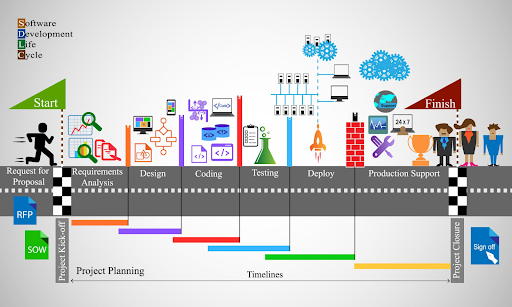There is always a methodical approach to implement as you go from one phase to the next, preventing any missteps from occurring between the conception of an idea and its eventual implementation. The same is true for startups. It will be tough to succeed if you instantly implement a plan or concept that comes to you without a defined strategy and direction.
This paper presents a comprehensive analysis of how software is created, including the 9 steps software development process used to build startups. It details the procedures we use, the groups that will be working on your project, and anything else you’ll need to know to start things going.
Best Practices for Planning a Software Development Project

The following will be the top three outstanding factors to consider for planning a software development project, especially for startups:
Details about a software product
It is essential that your specifications be as detailed as possible to provide a solid framework for your project. Simply possessing a fantastic concept isn’t enough; you need to have a thorough understanding of the product’s features and benefits as well. Carefully describe your needs, your company’s vision, the features and benefits of your product, and the market for it.
Acquired skills in a certain field
This is necessary because it is the driving force behind ensuring a good product-solution match. You use it as inspiration to make something that caters to the demands of your users, rather than churning out yet another piece of software that does nothing.
9 Steps Software Development Process Used to Build Startups

-
Evaluation of capability
If you’re confused solely when it comes to technical details, especially in terms of personnel to undertake, this is very normal and needs to happen. Hence, hiring a dedicated software development team is the next logical step to take in order to have access to experienced counsel in this area.
-
Think about if you need to bring in outside help
Or whether you’d rather do the building yourself instead! If you’re on a tight schedule and/or budget, you may want to consider outsourcing the development instead of doing it in-house.
Please consider explicitly can a mobile project be successfully completed by in-house resources? Also, in-depth knowledge of software creation, testing, user interface and user experience design, etc., is required.
-
Business activation
You’ll need a detailed business strategy, a list of potential direct and indirect rivals, and a set of ideas for making money if you want to succeed with your product. You may also need to create a minimal viable product (MVP) at this stage, which demonstrates the software solution’s fundamental needs and capabilities.
In certain cases, such as after the business concept has been validated, the design phase is when the MVP is developed. However, a minimum viable product (MVP) may be required to convince government bodies or angel investors to back your project.
Understanding product discovery and asking the proper product discovery questions to gain additional knowledge about your customers and market are essential for making the most of this stage.
-
Verification of concept
Validating an idea is a major undertaking. Finding out whether there is a market for what you want to make is an essential aspect of the product discovery process. At this stage, you test your ideas, assumptions, and best estimates to learn more about the true need for your product. Measuring it will help you schedule and allocate resources for your project.
Many methods and questions may be used to validate an idea. Now that problems have been identified, you can begin to formulate answers and identify aspects that will be valued in the final product.
-
Project estimation
The thorough estimate includes more in-depth planning for each stage, software features, SDLC models, and team members. In addition to this, it allots the hours required to create your software to the many specialists in your team, which helps account for the total development time.

We may all agree that a precise estimate is preferable than a vague one.
The final price of your goods may not be known for up to two weeks as we tally all the details. When providing a precise estimate, we additionally consider the underlying system and application architecture.
-
Performance management and practicality study
In-depth estimating and preparation may be finished after a thorough examination of requirements and feasibility. Before investing time and money into designing and developing a program, viability analysis determines whether the program can really meet the needs of its intended users.
When reviewing software viability, your requirements may be revised. Based on the results of the investigation, we may suggest improvements if any of them turn out to be inappropriate for your company or its intended audience in terms of technological feasibility, practicality, or legality. These may assist you acquire a more feasible and expense solution in the long term.
-
Development execution
You have reached the technical phase of the product development life cycle. You may refer to this as the “code” phase, since it is when the groundwork is laid for your digital creation. That is to say, this is the stage in which your Agile software development team actively participates in building out the necessary framework and features for the front and back ends of the application.
As part of the onboarding process, you will be asked to submit a statement of work (SOW) outlining the scope of the next development phase. This document, which was prepared by a project manager, provides a detailed explanation of the reasons why, when, and how certain tasks need to be completed. It covers all aspects of your project’s development services, from timelines and criteria to payments and finances.
-
Software testing
For various reasons, some new businesses treat software testing as an independent step. However, this method lengthens the time it takes to create an app and adds more work for quality assurance (QA) engineers.
As an alternative, your company should incorporate testing throughout the software development life cycle. They should do this before going on to the next phase of development so that they may find and fix any issues that may have been missed.
-
Software launch & Upgrade
An important milestone in every software development project is the launch date, which unveils the final solution to the intended users. The building projects of your business should be shown in the best possible light.
The product’s beta version may provide an early indicator of how customers will respond. To compile and make sense of these user insights, you also require data collecting and a way that works. Use the information to adjust future versions of the product to better meet the needs of users.
After an app is released to the public, the work of developing software for a startup is far from done. It’s important to keep tabs on the product after release to identify areas for development and to evaluate how well it’s doing in the industry.
Interesting Related Article: “Top Criteria for Choosing the Right Software Development Company“

